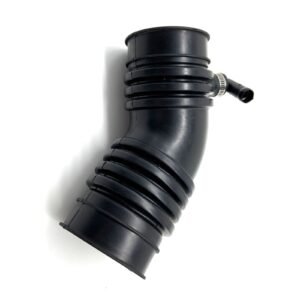During an inspection of an air intake rubber hose, there are several signs of wear or damage that you should look for.
Here are some common indicators that may suggest the need for replacement:
Cracks or Splits: Inspect the entire length of the hose for any visible cracks or splits. Over time, exposure to heat and engine fluids can cause the rubber to deteriorate, leading to the formation of cracks. Cracks can allow unfiltered air to enter the engine, affecting its performance.
Bulges or Swelling: Check for any bulges or swelling along the surface of the hose. Bulges can indicate internal damage or separation of the hose layers, compromising its structural integrity and potentially causing air leaks.
Soft or Mushy Texture: Press the hose gently with your fingertips. If it feels excessively soft, mushy, or spongy, it may indicate deterioration of the rubber material. A degraded hose may be prone to collapsing under suction or developing leaks.
Loose or Damaged Connections: Inspect the connections at each end of the hose. Check for loose or damaged clamps, connectors, or fittings. Loose connections can cause air leaks, affecting the intake airflow and potentially triggering engine performance issues.
Oil or Dirt Accumulation: Look for signs of oil or dirt accumulation on the surface of the hose. Excessive oil or dirt buildup may indicate leaks or improper sealing at the connection points. It can also suggest the presence of an engine oil leak, which should be addressed separately.
Discoloration or Fading: Pay attention to any significant discoloration or fading of the hose material. Over time, exposure to heat, UV rays, and chemicals can cause the hose to fade or change color. While discoloration alone may not be a critical issue, it can be an indication of age or prolonged exposure to harsh conditions.
Loose or Deteriorated Reinforcement: If the air intake hose has reinforcement layers, check for any signs of loose or deteriorated reinforcement. Ensure that the reinforcement is intact and securely embedded within the hose. Damaged reinforcement can compromise the hose’s strength and stability.
Vacuum Leaks or Whistling Sounds: During the inspection, listen for any whistling sounds or hissing noises while the engine is running. These sounds may indicate the presence of a vacuum leak, often caused by a damaged or loose air intake rubber hose.
If you notice any of these signs of wear or damage, it is advisable to replace the air intake rubber hose promptly. A damaged hose can adversely affect engine performance, fuel efficiency, and even lead to potential engine problems. Always consult your vehicle’s manufacturer guidelines or seek professional assistance if you are unsure about the condition of the air intake rubber hose or its replacement.
What are the potential consequences of not replacing a damaged air intake rubber hose?
Not replacing a damaged air intake rubber hose can lead to several potential consequences, including:
Reduced Engine Performance: The air intake system plays a vital role in supplying clean and filtered air to the engine for combustion. China air intake rubber hose A damaged hose may develop cracks, splits, or leaks, allowing unfiltered air to enter the engine. Unfiltered air may contain contaminants like dust, debris, or unburned fuel, which can hinder the combustion process. As a result, the engine may experience reduced power, decreased acceleration, and overall diminished performance.
Poor Fuel Efficiency: When an air intake rubber hose is damaged, it can disrupt the proper airflow into the engine. The engine control unit (ECU) relies on the intake airflow data to adjust the fuel-to-air ratio for optimal combustion. If the air intake is compromised, the ECU may inject excess fuel, leading to a rich fuel mixture. A rich fuel mixture can cause poor fuel efficiency, resulting in increased fuel consumption and decreased mileage.
Engine Misfires: Leaks or cracks in the air intake rubber hose can affect the consistency of the airflow into the engine cylinders. Inconsistent airflow disrupts the proper air-fuel mixture, leading to engine misfires. Engine misfires can cause rough idling, stumbling or hesitation during acceleration, and an overall unsteady engine operation.
Increased Emissions: An air intake rubber hose that is damaged or leaking can contribute to increased emissions. Unfiltered air entering the engine can contain harmful particles that can affect the combustion process and lead to incomplete burning of fuel. This can result in higher levels of pollutants being emitted from the exhaust, including hydrocarbons (HC), carbon monoxide (CO), and nitrogen oxides (NOx), contributing to environmental pollution.
Potential Engine Damage: In severe cases, a damaged air intake rubber hose can lead to more significant engine issues. If the hose collapses due to deterioration or if a large leak occurs, the engine may experience a loss of air supply, causing excessively lean conditions. Lean conditions can lead to overheating, increased cylinder temperatures, and potential engine damage, such as burned valves or pistons.
It is important to address any damaged air intake rubber hose promptly to maintain the proper functioning of the engine and prevent potential long-term consequences. Regular inspections and timely replacements are essential to ensure an efficient and reliable air intake system.
